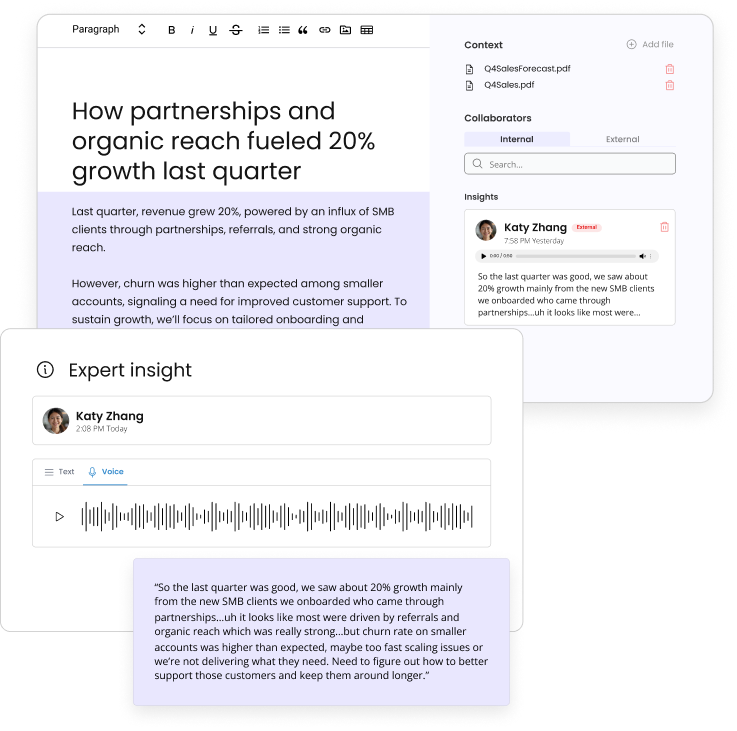Table of Contents

Authority scales when expertise comes first
Wordbrew helps teams collect expert insight before AI ever writes a word.
Built for expert-led, review-safe content
- Home
- »
- Content Marketing
- »
- 2024 Strategy For Thought Leadership Content
-
Wordbrew
- 10 minutes read time
2024 Strategy For Thought Leadership Content
- Home
- »
- Content Marketing
- »
- 2024 Strategy For Thought Leadership Content
2024 Strategy For Thought Leadership Content
Table of Contents

What does your content say about your brand? Ask yourself:
- Does it position you as an industry authority with the know-how to lead your customers?
- Does it offer valuable insights your audience won’t find anywhere else?
- Does it provide actionable strategies for change that inspire social sharing?
- Does it drive quality backlinks from reputable websites?
Thought leadership content marketing does all that and more. It can be one of the most effective tools in your content strategy—educating, inspiring, and adding value for your customers.
Research has shown that 64% of B2B consumers see thought leadership content as a more trustworthy way to assess a brand’s expertise than its marketing or product content.
But thought leadership fails when it is too generic and lacks original insight. In this guide, I’ll teach you how to effectively define, create, and share valuable content to get your brand heard.
TL;DR: Thought leadership content marketing
- Thought leadership content builds authority and adds value for your customers.
- It leverages your unique perspectives and insights to establish you as a subject matter expert.
- Effective thought leadership content educates, inspires, and builds trust with your audience.
- Create high-quality, original content that resonates with your target audience.
- Thought leadership content is about generating leads and building trust, brand awareness, and industry influence.
What is thought leadership content?
Thought leadership content leverages your unique perspectives, experiences, insights, and knowledge to position you and your brand as a leading authority and subject matter expert in your industry or niche.
@wordbrewhq A little bit of ‘hello’ never hurt nobody 🥺#fyp #contentcreator #freelancing #writingcommunity
♬ Permission to Dance – BTS
Authority content comes from genuine insight. There’s no prerequisite to being famous or a big name, but you do need to know what you are talking about and be able to share your knowledge in an inspiring, original way that adds value for the reader.
The world’s best leaders and visionaries earn trust not just by presenting data, but also by telling great stories. In this Ted Talk, leadership consultant Karen Eber explains how effective storytelling can create empathy and inspire action:
Karen Eber: How your brain responds to stories — and why they’re crucial for leaders | TED
Companies like SparkToro and Deloitte are great examples of thought leadership content. These companies have established themselves as industry experts through innovative approaches and data-driven insights.
On the individual level, influential thought leaders such as Oprah Winfrey and Seth Godin have leveraged their expertise and personal brands to shape public discourse and inspire millions.
#AskGaryVee Episode 185: Seth Godin on Thought Leaders, Psychics & The Future of the Internet
Personal finance expert Dave Ramsey is another good example of a thought leader who shares insights on X/Twitter using short, easily digestible posts.
These thought leaders share their knowledge through various platforms and mediums, from books and podcasts to social media and speaking engagements.
Good thought leadership marketing content educates and inspires your audience. Bringing value to your customer experience with authority content automatically positions you as a leader in your field—building trust, brand awareness, loyalty, and increasing revenue.
How to become a thought leader: a step-by-step guide
Becoming a thought leader involves building a solid reputation as an industry expert and influencer in your field. Here are some steps to help establish yourself as a subject matter expert.
1. Identify your niche
Identify a few areas of expertise that you can create content around. Consider your industry experience and what insights and opinions you can offer.
- Choose a specific area within your industry where you can demonstrate subject matter expertise and unique insights.
- Think about what has been said before and what hasn’t. Can you add a new perspective?
- What are your competitors talking about? How can you distinguish yourself from competitors?
- Figure out what type of content resonates with your audience. Analyze where you get the most engagement—on social media, blog posts, videos, etc.—and think about the platforms on which your target audience is most active.
- Use authoritative, well-researched thought leadership content as the backbone of your content strategy to ensure your brand stands out.
2. Create high-quality content
Test a few channels to see what works for you and your audience.
Good thought leadership content takes many forms, from whitepapers to opinion pieces, personal experiences, industry analysis, trend reports, and unique perspectives on current events.
Here’s an example of thought leadership from our own founder, Georgia Austin:
Pro tip: Creating long-form thought leadership marketing content can be tedious (and time-consuming!). Wordrew can connect with the best subject matter experts on the market to create your thought leadership content. Our network of subject matter experts from various industries and backgrounds helps businesses like yours create truly valuable thought leadership content.
Which types of content are most effective for marketers? According to research from the Content Marketing Institute’s 2024 B2B Content Marketing Benchmarks, Budgets, and Trends report:
“Fifty-three percent say case studies/customer stories and videos deliver some of their best results. Almost as many (51%) names thought leadership e-books or white papers, 47% short articles, and 43% research reports.”
While long-form blog posts have been the go-to for authority content, there’s no limit to where you can share your insights:
- Blogging: Regularly publish blog posts that offer in-depth analysis, innovative ideas, and practical advice.
- Whitepapers and eBooks: Develop comprehensive guides and research papers to showcase your industry expertise. This valuable content is provided in exchange for customer information, such as an email address, making them useful tools for lead capture.
- Articles and opinion pieces: Write for industry publications and reputable websites.
- Share insights: Post regularly on social media platforms, sharing new insights, commenting on industry trends, and engaging with your target audience.
- LinkedIn thought leadership: Use LinkedIn to publish articles, join relevant groups, and connect with other professionals in your field.
- Conferences and webinars: Speak at industry conferences, webinars, and events. Share your knowledge and engage with the audience.
- Panels and workshops: Participate in panel discussions and conduct workshops.
- Original research: Conduct and publish original new insights into your field.
- Case studies: Share detailed case studies that highlight successful projects, innovations, or solutions you’ve developed.
Here’s what to keep in mind when releasing thought leadership content on different channels:
1. Website: Publish research, insights, or industry analysis as part of your online content or lead capture strategy.
2. Blog: Ideal for sharing opinions, experiences, tips, comments on industry news, analysis, and unique insights.
3. Social media: Think infographics or headline statistics from research data, expert quotes, and thought-provoking insights in written or video format.
4. Events: Look for keynote speaking opportunities, panel discussions, or webinar appearances.
5. Podcasts: Your own, or appear as a guest and share your episode.
Great thought leadership is genuine and authentic—share your personal story, experiences and insights as an industry leader. And don’t forget to repurpose each piece of executive thought leadership content you publish—tailored for each new channel and audience:
- Turn whitepapers or opinion pieces into multiple X/Twitter threads.
- Data and diagrams included in blogs are great talking points for Instagram or LinkedIn posts.
- Keynote speeches can be filmed and shared on YouTube and other social channels or written up as a series of blog posts.
If you want some thought leadership content examples, Moz does this well, repurposing its informative “Whiteboard Fridays” videos into a series of blog posts.
3. Keep a consistent cadence
Remember to regularly update the content on your blog, social media channels, and other online platforms to keep your audience engaged and informed!
4. Measure and adapt
Set KPIs to measure performance. Defining clear goals and a way to track progress toward them ensures you understand what content is working—and what isn’t.
- Gather feedback from your audience to understand what resonates with them.
- Use analytics to measure the impact of your content and adjust your strategy accordingly.
- Review and adjust your strategy to keep your insights fresh and aligned with your audience.
5. Stay educated
Attending courses, reading books, and staying updated with the latest research in your field will enhance your knowledge and subject matter expertise. You can also build credibility by obtaining relevant certifications.
6. Build your personal brand
Create a professional website or blog to bring all your content together and showcase your industry expertise. It’s a great way to build a strong personal brand that reflects your values and unique perspectives.
What are the benefits of thought leadership content?
Effective thought leadership content marketing adds value, builds trust, and helps increase your brand awareness—all of which drive increased leads and revenue.
According to Edelman’s 2024 B2B Thought LeadersReport, 52% of decision-makers and 54% of C-level executives spend an hour or more on average per week reading thought-leadership content. And those executives believe in thought leadership more than marketing materials:
“73% of decision-makers say that an organization’s thought-leadership content is a more trustworthy basis for assessing its capabilities and competencies than its marketing materials and product sheets.”
But, thought leadership content isn’t just about generating more leads for your business. Its value goes beyond the bottom line. It opens up partnership opportunities and helps give back to your wider industry community.
Is thought leadership content for everyone?
A recent Grist survey revealed that 63% of B2B buyers are turned off by thought leadership content that is too generic.
Authoritative, insightful content that adds value is the key to thought leadership.
Only follow a thought leadership marketing strategy if you or your brand has the expertise and experience to be a proper authority in your industry. Any of these thought leadership don’ts will eventually alienate your customers and sow a seed of distrust in your brand:
- Plagiarism.
- Too promotional or generic.
- Lacks a depth of knowledge.
- Produced without a consistently high standard.
- Relies solely on controversial stances to build your audience.
According to the Financial Times Learning from Leaders Report, there are three fundamental elements to engaging thought leadership content.
- Powerful data.
- Compelling storytelling.
- Strong design.
If the content you are planning is lacking in any of these three areas, don’t write it.
Is all thought leadership content meant to get more leads?
Simple answer: No.
That’s one of the goals of content marketing. And no, they’re not exactly the same thing.
Content marketing and thought leadership marketing are both great ways for businesses to connect with target audiences, but they each have unique focuses and approaches:
- Purpose: Content marketing is more about engaging and converting customers, while a thought leadership approach focuses on establishing authority and influencing industry opinions.
- Type of content: Content marketing tends to be broader and more varied, while thought leadership is often deeper and more specialized.
- Audience engagement: Content marketers provide immediate value and solutions to customers’ problems, while thought leaders aim to provoke thought and discussion within the industry.
Thought leadership is a part of your content strategy. Your focus should be to teach your audience about something new in a new way. You do this through data storytelling, videos, or written content.
Showcasing your expertise builds trust—trust that you and your brand can solve your customers’ problems. As 95% of purchasing decisions are subconscious, trust is a powerful way to encourage buyers to commit.
Pro tip: People don’t buy from brands; people buy from people. Sharing your unique perspectives helps build a picture of the people behind your brand. Thought leaders build the relationships that cultivate sales.
Not sure how that’s different from content marketing? Here’s a guide on content marketing vs thought leadership.
How to ensure your thought leadership content doesn’t fail
When Grist released its Value of B2B Thought Leadership survey, it revealed three key takeaways. Thought leadership content underperforms when:
- It’s too promotional.
- The insights and ideas included aren’t original.
- It promotes the brand or author instead of offering solutions to the reader’s problems.
Ultimately, the best way to ensure your thought leadership delivers for your brand is to ensure the person behind it is a genuine authority on the subject—someone who can provide new insights backed by robust data and thorough research.
Interestingly enough, since the start of the pandemic, thousands of people have turned to LinkedIn to demonstrate their expertise with high-quality thought leadership content.
So, if you’re just starting, take some time to explore different leaders in your industry and see how they create content for LinkedIn.
Scale your thought leadership strategy with Wordbrew
Who better to transform your insights and expertise into well-articulated content than subject matter specialists with in-depth backgrounds in your industry?
That’s where Wordbrew comes in. We only work with specialist writers, not generalists, to craft consistently high-quality content backed by an innate understanding of your niche. If you need to scale quickly, we have the resources to make it happen.
You are the industry expert―at Wordbrew, every draft we create is based on your own data and insights, resulting in customized drafts for your niche or industry. Ready to stand out from your competitors and scale your thought leadership content marketing? Contact us today to get started!
FAQs
Q. How do you write thought leadership content marketing?
A. The best way to write thought leadership content is to become a genuine expert in your field. Find your niche and provide insightful, new perspectives. Think about your customer problems and identify solutions based on your experiences and lessons learned, and share authoritative thought-provoking takes on industry news and trends.
Q. Why is thought leadership content important?
A. Thought leadership content is important because:
- It increases your brand awareness and visibility, driving trust and increasing sales.
- It establishes you as the go-to expert in your field.
- It helps prove to your customers that you understand their business challenges and can provide solutions to their problems.
Q. Is thought leadership the same thing as content marketing?
A. Thought leadership is one branch of your content strategy.
Content marketing is all about sharing helpful, interesting, and relevant content to connect and engage with a specific audience. The ultimate goal is to drive profitable customer action.
- For example, a company that sells gardening tools might create blog posts about gardening tips, how-to videos on using their tools, or infographics on plant care as part of their content marketing strategy.
A thought leadership approach means positioning yourself or your company as an expert in a specific field or industry. The goal of thought leadership marketing is to inspire and influence others by sharing relevant insights, ideas, and viewpoints.
- For example, a tech company’s CEO might write thought pieces on the future of artificial intelligence, participate in panel discussions at industry conferences, or share research findings on social media as part of their thought leadership strategy.
